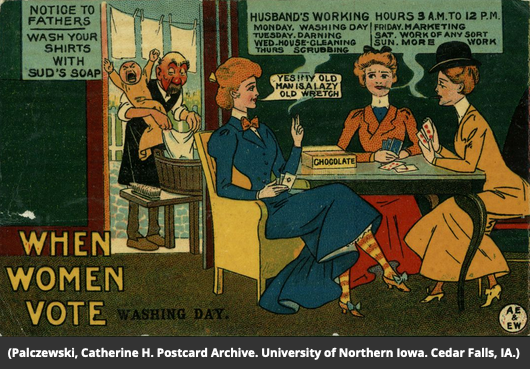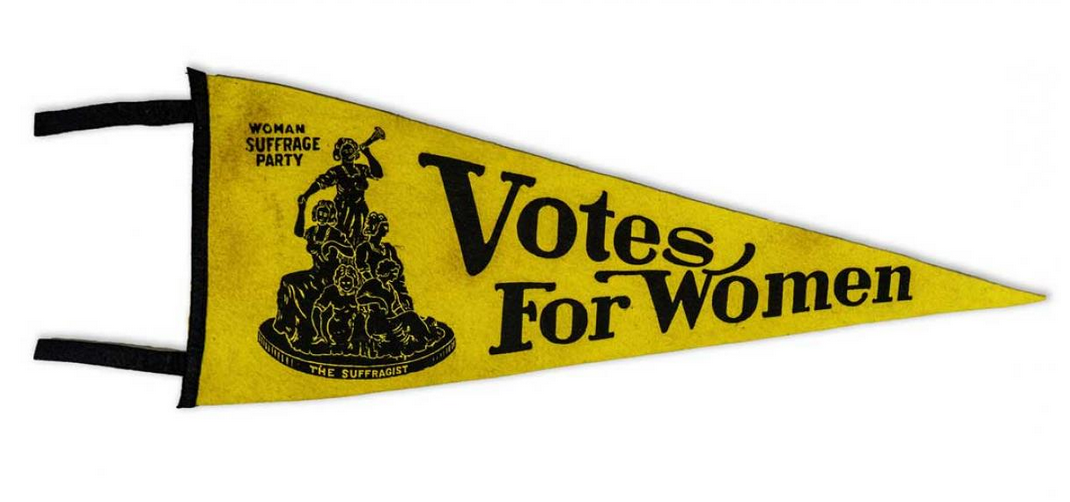Encyclopedia Dubuque
"Encyclopedia Dubuque is the online authority for all things Dubuque, written by the people who know the city best.”
Marshall Cohen—researcher and producer, CNN
Affiliated with the Local History Network of the State Historical Society of Iowa, and the Iowa Museum Association.
WOMEN'S SUFFRAGE MOVEMENT IN DUBUQUE: Difference between revisions
No edit summary |
No edit summary |
||
| Line 5: | Line 5: | ||
In 1870, Mary Spencer became the first woman appointed unanimously to a position within the Iowa legislature. Suffragists everywhere saw the appointment as a major victory. The same year, the Iowa legislature approved a resolution to amend the constitution, allowing women to vote. Progressives in Iowa believed the vote for women would soon be realized. (3) Although the bill was defeated in 1872, a core group suffragettes remained alive in Iowa until the passage of the 19th amendment. (4) During this time Annie Savery, a Des Moines resident and suffragist, spoke for women’s intellectual independence. Even fellow suffragists rejected extremist ideal. Moderates saw her as someone who would scare supporters away from the cause. (5) | In 1870, Mary Spencer became the first woman appointed unanimously to a position within the Iowa legislature. Suffragists everywhere saw the appointment as a major victory. The same year, the Iowa legislature approved a resolution to amend the constitution, allowing women to vote. Progressives in Iowa believed the vote for women would soon be realized. (3) Although the bill was defeated in 1872, a core group suffragettes remained alive in Iowa until the passage of the 19th amendment. (4) During this time Annie Savery, a Des Moines resident and suffragist, spoke for women’s intellectual independence. Even fellow suffragists rejected extremist ideal. Moderates saw her as someone who would scare supporters away from the cause. (5) | ||
[[File:aspc-1.png|250px|thumb|left|Anti-sufferage postcards. Image courtesy: Smithsonian.com Online: https://www.smithsonianmag.com/smart-news/these-anti-suffragette-postcards-warned-against-giving-women-vote-180959828/]] | |||
[[File:aspc-2.png|250px|thumb|right|Anti-sufferage postcards. Image courtesy: Smithsonian.com Online: https://www.smithsonianmag.com/smart-news/these-anti-suffragette-postcards-warned-against-giving-women-vote-180959828/]] | |||
Looking for allies, woman's suffrage joined with the temperance movement in 1874. Taking the form of the Women’s Christian Temperance Union, suffragettes saw getting the vote as the only way to control alcoholism. (6) In public debate, the issue often became linked to the sale and manufacture of alcohol. Women were seen as allies of those wishing to prohibit or greatly limit such sales, and therefore, prohibitionists were usually advocates of granting the vote to women. When a prominent women’s suffrage leader in New York, Victoria Woodhull, however, spoke out for greater sexual freedom, the suffrage movement became accused of advocating for “free love.” (7) | Looking for allies, woman's suffrage joined with the temperance movement in 1874. Taking the form of the Women’s Christian Temperance Union, suffragettes saw getting the vote as the only way to control alcoholism. (6) In public debate, the issue often became linked to the sale and manufacture of alcohol. Women were seen as allies of those wishing to prohibit or greatly limit such sales, and therefore, prohibitionists were usually advocates of granting the vote to women. When a prominent women’s suffrage leader in New York, Victoria Woodhull, however, spoke out for greater sexual freedom, the suffrage movement became accused of advocating for “free love.” (7) | ||
The history of women's suffrage in Iowa from 1894 to 1919 was one of gradual but steady progress. In 1894 women in Iowa were granted partial suffrage. They were given the right to vote on bond issues and tax increases for schools and municipalities. While another positive step, it was far from the suffragettes' goal. In 1908 the city of Des Moines threatened even this advance when it denied women the vote in these cases. Mary Jane Whitely's successful suit of the city established an important precedent. (8) | The history of women's suffrage in Iowa from 1894 to 1919 was one of gradual but steady progress. In 1894 women in Iowa were granted partial suffrage. They were given the right to vote on bond issues and tax increases for schools and municipalities. While another positive step, it was far from the suffragettes' goal. In 1908 the city of Des Moines threatened even this advance when it denied women the vote in these cases. Mary Jane Whitely's successful suit of the city established an important precedent. (8) | ||
In 1916, the state legislature submitted to Iowa voters (still all men) a constitutional amendment to remove the word “male” as a requirement to vote. Areas where pro-alcohol sentiments were strong opposed it as did liquor manufacturers. The Catholic Church, which pointed to biblical passages citing the man as head of the family, also opposed it. Counties along the Mississippi and Missouri Rivers where these two groups were strong racked up huge majorities to narrowly defeat the measure. ( | In 1916, the state legislature submitted to Iowa voters (still all men) a constitutional amendment to remove the word “male” as a requirement to vote. Areas where pro-alcohol sentiments were strong opposed it as did liquor manufacturers. The Catholic Church, which pointed to biblical passages citing the man as head of the family, also opposed it. Some churches like the Methodists, Presbyterians and Baptists were often very strong in their support of granting women the vote. (9) Counties along the Mississippi and Missouri Rivers where these two groups were strong racked up huge majorities to narrowly defeat the measure. (10) | ||
On April 19th, 1919, the women of Iowa were finally granted the right to vote in presidential elections. Three months later on July 2nd, 1919 Iowa ratified the 19th amendment in full, making them the tenth state to do so. Over a year later Tennessee ratified the 19th amendment on August 18th, 1920. With their acceptance of the new amendment, every eligible woman in the United states was granted the vote. ( | On April 19th, 1919, the women of Iowa were finally granted the right to vote in presidential elections. Three months later on July 2nd, 1919 Iowa ratified the 19th amendment in full, making them the tenth state to do so. Over a year later Tennessee ratified the 19th amendment on August 18th, 1920. With their acceptance of the new amendment, every eligible woman in the United states was granted the vote. (11) | ||
--- | --- | ||
| Line 33: | Line 35: | ||
8. "Women's Suffrage in Iowa"..... | 8. "Women's Suffrage in Iowa"..... | ||
9. "Women's Suffrage | 9. "Women's Suffrage" Iowa Department of Cultural Affairs... | ||
10. "Women's Suffrage in Iowa"... | 10. "Women's Suffrage," | ||
11. "Women's Suffrage in Iowa"... | |||
Revision as of 19:36, 16 April 2019
WOMEN'S SUFFRAGE MOVEMENT IN DUBUQUE. Iowa's first constitutions restricted the right to vote to white males. Most Iowans, like people elsewhere at the time, believed that the womens' role was in running the household and caring for children; men held jobs and represented the family in public affairs. Although a women’s suffrage convention in 1848 in Seneca Falls, New York, called for expanding political rights for women, but the issue did not gain much attention in Iowa until immediately after the CIVIL WAR. As debate focused on the status of freed black former slaves, some women and men began to argue that women also also be allowed to vote. (1)
The first woman suffrage association was formed in Dubuque in 1869. Local suffrage organizations spread across the state to hear speeches about women's rights and to learn how to get a law passed to allow women to vote. (2)
In 1870, Mary Spencer became the first woman appointed unanimously to a position within the Iowa legislature. Suffragists everywhere saw the appointment as a major victory. The same year, the Iowa legislature approved a resolution to amend the constitution, allowing women to vote. Progressives in Iowa believed the vote for women would soon be realized. (3) Although the bill was defeated in 1872, a core group suffragettes remained alive in Iowa until the passage of the 19th amendment. (4) During this time Annie Savery, a Des Moines resident and suffragist, spoke for women’s intellectual independence. Even fellow suffragists rejected extremist ideal. Moderates saw her as someone who would scare supporters away from the cause. (5)


Looking for allies, woman's suffrage joined with the temperance movement in 1874. Taking the form of the Women’s Christian Temperance Union, suffragettes saw getting the vote as the only way to control alcoholism. (6) In public debate, the issue often became linked to the sale and manufacture of alcohol. Women were seen as allies of those wishing to prohibit or greatly limit such sales, and therefore, prohibitionists were usually advocates of granting the vote to women. When a prominent women’s suffrage leader in New York, Victoria Woodhull, however, spoke out for greater sexual freedom, the suffrage movement became accused of advocating for “free love.” (7)
The history of women's suffrage in Iowa from 1894 to 1919 was one of gradual but steady progress. In 1894 women in Iowa were granted partial suffrage. They were given the right to vote on bond issues and tax increases for schools and municipalities. While another positive step, it was far from the suffragettes' goal. In 1908 the city of Des Moines threatened even this advance when it denied women the vote in these cases. Mary Jane Whitely's successful suit of the city established an important precedent. (8)
In 1916, the state legislature submitted to Iowa voters (still all men) a constitutional amendment to remove the word “male” as a requirement to vote. Areas where pro-alcohol sentiments were strong opposed it as did liquor manufacturers. The Catholic Church, which pointed to biblical passages citing the man as head of the family, also opposed it. Some churches like the Methodists, Presbyterians and Baptists were often very strong in their support of granting women the vote. (9) Counties along the Mississippi and Missouri Rivers where these two groups were strong racked up huge majorities to narrowly defeat the measure. (10)
On April 19th, 1919, the women of Iowa were finally granted the right to vote in presidential elections. Three months later on July 2nd, 1919 Iowa ratified the 19th amendment in full, making them the tenth state to do so. Over a year later Tennessee ratified the 19th amendment on August 18th, 1920. With their acceptance of the new amendment, every eligible woman in the United states was granted the vote. (11)
---
Source:
1. "Women's Suffrage," Iowa Department of Cultural Affairs, Online: https://iowaculture.gov/history/education/educator-resources/primary-source-sets/womens-suffrage
2. "The Fight for Women's Suffrage," Iowa Pathways, Online: http://www.iptv.org/iowapathways/mypath/fight-womens-suffrage
3. "Women's Suffrage in Iowa," https://www.arcgis.com/apps/MapSeries/index.html?appid=3c04988656ba4a71a186a32503233f42
4. Ibid.
5. Ibid.
6. Ibid.
7. "Women's Suffrage,"
8. "Women's Suffrage in Iowa".....
9. "Women's Suffrage" Iowa Department of Cultural Affairs...
10. "Women's Suffrage,"
11. "Women's Suffrage in Iowa"...


